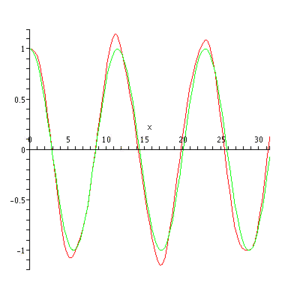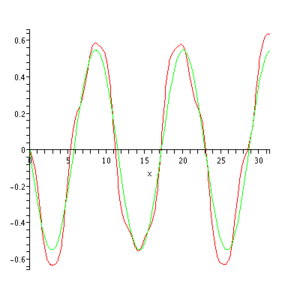Mathieu function
In mathematics, the Mathieu functions are certain special functions useful for treating a variety of problems in applied mathematics, including:
- vibrating elliptical drumheads,
- quadrupole mass analyzers and quadrupole ion traps for mass spectrometry
- wave motion in periodic media, such as ultracold atoms in an optical lattice
- the phenomenon of parametric resonance in forced oscillators,
- exact plane wave solutions in general relativity,
- the Stark effect for a rotating electric dipole,
- in general, the solution of differential equations that are separable in elliptic cylindrical coordinates.[1]
They were introduced by Émile Léonard Mathieu (1868) in the context of the first problem.
Mathieu equation
The canonical form for Mathieu's differential equation is[2]
- or with
The Mathieu equation is a Hill equation with only 1 harmonic mode.
Closely related is Mathieu's modified differential equation
which follows on substitution .
The two above equations can be obtained from the Helmholtz equation in two dimensions, by expressing it in elliptical coordinates and then separating the two variables. This is why they are also known as angular and radial Mathieu equation, respectively.
The substitution transforms Mathieu's equation to the algebraic form
This has two regular singularities at and one irregular singularity at infinity, which implies that in general (unlike many other special functions), the solutions of Mathieu's equation cannot be expressed in terms of hypergeometric functions.
Mathieu's differential equations arise as models in many contexts, including the stability of railroad rails as trains drive over them, seasonally forced population dynamics, the four-dimensional wave equation, and the Floquet theory of the stability of limit cycles.
Floquet solution
According to Floquet's theorem[3] (or Bloch's theorem),[4] for fixed values of a,q, Mathieu's equation admits a complex valued solution of form
where is a complex number, the Floquet exponent (or sometimes Mathieu exponent), and P is a complex valued function which is periodic in with period . However, P is in general not sinusoidal. In the example plotted below, (real part, red; imaginary part, green):

Mathieu sine and cosine
For fixed a,q, the Mathieu cosine is a function of defined as the unique solution of the Mathieu equation which
- takes the value ,
- is an even function, hence .
Similarly, the Mathieu sine is the unique solution which
- takes the value ,
- is an odd function, hence .
These are real-valued functions which are closely related to the Floquet solution:
The general solution to the Mathieu equation (for fixed a,q) is a linear combination of the Mathieu cosine and Mathieu sine functions.
A noteworthy special case is
i.e. when the corresponding Helmholtz equation problem has circular symmetry.
In general, the Mathieu sine and cosine are aperiodic. Nonetheless, for small values of q, we have approximately
For example:


Periodic solutions
Given , for countably many special values of , called characteristic values or simply eigenvalues, the Mathieu equation admits solutions which are periodic with period or period . The characteristic values of the Mathieu cosine and sine functions respectively are written and , where n is a natural number. The periodic special cases of the Mathieu cosine and sine functions are often written , or and , or respectively where is an odd integer, although they are traditionally given a different normalization (namely, that their L2 norm equal ). Therefore, for positive q, we have
Here are the first few periodic Mathieu cosine functions for q = 1:

Note that, for example, (green) resembles a cosine function, but with flatter hills and shallower valleys.
The series expansions of periodic Mathieu functions in ascending powers of are most easily obtained by perturbation theory.[5] For large values of two adjacent periodic solutions merge together to an asymptotic solution for large values of as shown in the book of Müller-Kirsten.
Asymptotic solutions
For large values of asymptotic expansions of periodic Mathieu functions have been given by R.B. Dingle and H.J.W. Müller.[6] Expansions for both small values of and large values of and their merging together have been given in.[7] For higher and higher barriers of the periodic potential ≈ , and that means for large values of , the potential approaches asymptotically a system of independent harmonic oscillators with oscillator quantum number (say) for an integer or zero, and this leads to the leading approximation of the eigenvalue for . Higher order terms can be obtained by perturbation theory. One obtains in this way three pairs of asymptotic solutions which can be matched in common domains of overlap. Imposing the boundary conditions required for periodic solutions, one obtains the asymptotic expansion of the parameter , i.e. where is a positive integer or zero. Thus, for the barriers of the periodic potential are infinitely high and there is no quantum mechanical tunneling through these barriers. Lowering these barriers, tunneling becomes possible, and the parameter is only approximately an integer. For details see the above references. In the study of asymptotic expansions, the behavior of the function under consideration for large values of a parameter like above plays a significant role. In the case of periodic Mathieu functions and spheroidal wave functions the large order behavior of the eigenvalue expansion has been derived in.[8]
Solutions to the modified Mathieu equation
An important application of the modified Mathieu equation arises in the quantum mechanics of singular potentials. For the one particular singular potential the radial Schrödinger equation
can be converted into the equation
The transformation is achieved with the following substitutions
With the replacements
one obtains the periodic Mathieu equation
The solution of the above radial Schrödinger equation (for the specific singular potential) in terms of solutions of the modified Mathieu equation and the derivation of the S-matrix and the absorptivity has been given by Müller-Kirsten.[9]
Large order behavior of Mathieu functions
The form of the coefficients of the late terms in the asymptotic expansions of the characteristic numbers (eigenvalues) of Mathieu and prolate and spheroidal wave functions has been worked out in a paper of Dingle and Müller.[10] Further discussion of this behavior, particularly in relation to the asymptotic level splitting, can be found in the paper of H.J.W. Müller-Kirsten.[11]
See also
- Monochromatic electromagnetic plane wave, an example of an important exact plane wave solution to the Einstein field equation in general relativity which is expressed using Mathieu cosine functions.
- Inverted pendulum
- Lamé function
- Quadrupole ion trap (also called Paul-trap), an example with direct use of eigenvalue expansions of the Mathieu equation.[12]
References
- ↑ Oliva-Leyva, M.; Fernández de Cossío, J.; Trallero-Giner, C. (2014-01-01). "Free wave modes in elliptic cylindrical containers". European Journal of Mechanics - B/Fluids. 43: 185–190. doi:10.1016/j.euromechflu.2013.09.003.
- ↑ J. Meixner and F.W. Schäfke, Mathieusche Funktionen und Sphäroidfunktionen (Springer, 1954)
- ↑ G. Floquet, Ann. Ecole norm. sup. 12 (1883) 47.
- ↑ F. Bloch, Z. Physik 52 (1928) 555.
- ↑ Harald J.W. Müller-Kirsten, Introduction to Quantum Mechanics: Schrödinger Equation and Path Integral, 2nd ed. (World Scientific, 2012), Chapter 17 on Periodic Potentials; H.H. Aly, H.J.W. Müller-Kirsten and N. Vahedi-Faridi, J. Math. Phys. 16 (1975) 961.
- ↑ R.B. Dingle and H.J.W. Müller-Kirsten, Asymptotic Expansions of Mathieu Functions and their Characteristic Numbers, J. reine u. angew. Math. 211 (1962) 11 - 32; H.J.W. Müller, On Asymptotic Expansions of Mathieu Functions, J. reine u. angew. Math. 211 (1962) 179 - 190.
- ↑ H.J.W. Müller-Kirsten: Introduction to Quantum Mechanics: Schrödinger Equation and Path Integral, 2nd ed. 2012, World Scientific.
- ↑ R.B. Dingle and H.J.W. Müller,The Form of the Coefficients of the Late Terms in Asymptotic Expansions of the Characteristic Numbers of Mathieu and Spheroidal Wave Functions, J. reine u. angew. Math. 216 (1964) 123 - 133.
- ↑ H.J.W. Müller-Kirsten, Introduction to Quantum mechanics: Schrödinger Equation and Path Integral, World Scientific, 2012, ISBN 978-981-4397-73-5, Chapter 19 on Singular Potentials.
- ↑ R.B. Dingle and H.J.W. Müller, The Form of the Coefficients of the Late Terms in Asymptotic Expansions of the Characteristic Numbers of Mathieu and Spheroidal Wave Functions, J. reine angew. Math. 216 (1964) 123-133.
- ↑ H.J.W. Müller-Kirsten, Perturbation Theory, Level-Splitting and Large-Order Behavior, Fortschr. Phys. 34 (1986) 775-790.
- ↑ R.E. March, An Introduction to Quadrupole Ion Trap Mass Spectroscopy, J. Mass Spectrometry 32 (1997) 351-369.
- Mathieu, E. (1868). "Mémoire sur Le Mouvement Vibratoire d'une Membrane de forme Elliptique". Journal de Mathématiques Pures et Appliquées: 137–203.
- Gertrude Blanch, "Chapter 20. Mathieu Functions", in Milton Abramowitz and Irene A. Stegun, eds., Handbook of Mathematical Functions with Formulas, Graphs, and Mathematical Tables (Dover: New York, 1972)
- McLachlan, N. W. (1962 (reprint of 1947 ed.)). Theory and application of Mathieu functions. New York: Dover. LCCN 64016333. Check date values in:
|date=(help) - Wolf, G. (2010), "Mathieu Functions and Hill's Equation", in Olver, Frank W. J.; Lozier, Daniel M.; Boisvert, Ronald F.; Clark, Charles W., NIST Handbook of Mathematical Functions, Cambridge University Press, ISBN 978-0521192255, MR 2723248
External links
- Hazewinkel, Michiel, ed. (2001), "Mathieu functions", Encyclopedia of Mathematics, Springer, ISBN 978-1-55608-010-4
- Timothy Jones, Mathieu's Equations and the Ideal rf-Paul Trap (2006)
- Weisstein, Eric W. "Mathieu function". MathWorld.
- Mathieu equation, EqWorld
- List of equations and identities for Mathieu Functions functions.wolfram.com
- NIST Digital Library of Mathematical Functions: Mathieu Functions and Hill's Equation